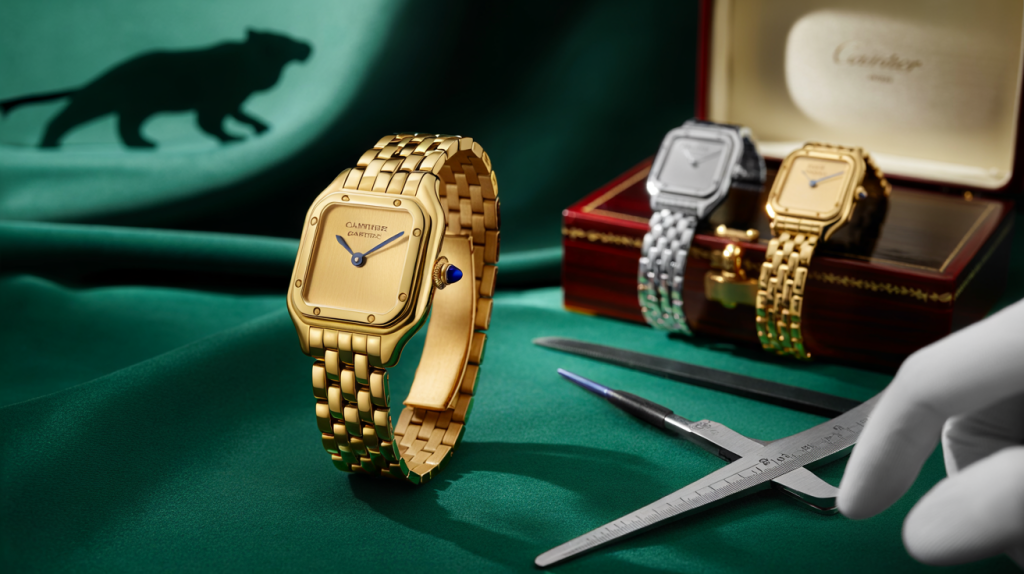Vintage Panthère de Cartier decoded: history, dates, record sales and a practical checklist to buy with confidence. Authentic, stylish, timeless.
One glance and the appeal clicks. The vintage Panthère de Cartier watch and jewellry line blends feline elegance with sharp geometry, the kind that looks effortlessly right in 2025 as it did in the 1980s. Interest keeps climbing because the story is rich, the design is instantly readable, and the market for good examples stays competitive.
Here is the context that matters. The panther entered Cartier’s world in 1914 on a wristwatch with diamond and onyx spots, a date documented by Christie’s. Jeanne Toussaint, appointed head of haute joaillerie in 1933 according to Cartier’s archives, turned the animal into a lasting emblem. The Panthère de Cartier watch itself arrived in 1983, then returned in 2017, a relaunch covered by Hodinkee that reminded everyone why the bracelet and case silhouette remains a magnet.
Panthère de Cartier vintage: why this icon still bites
The main idea is simple. Vintage Panthère pieces deliver everyday luxury with a precise set of codes that feel current. The square case with rounded corners, a bezel held by eight visible screws, and a fluid five row bracelet bring soft sparkle without shouting.
Collectors observe that the watch wears slim, often under 6 millimeters for small references, so it slips under a cuff and looks graceful on the wrist. The design reads like jewelry first, timekeeper second, which is exactly the point for many buyers.
The problem most face is confidence. How to choose a period correct example, avoid costly over polishing, and decide between steel, two tone or full gold. The answer lives in a few dates and design details that can be checked in minutes.
Key dates and details: what serious buyers look for
Dates anchor the hunt. The first three dimensional panther appeared in 1948 on a brooch for Wallis, Duchess of Windsor, with a follow up in 1949, documented by Cartier and widely cited by Christie’s and Sotheby’s. That creative line sets the stage for the 1983 launch of the Panthère watch, which adopted the cat’s name and attitude.
Sizes matter. Hodinkee reported during the 2017 revival that Cartier offered two core watch sizes, roughly 22 millimeters and 27 millimeters. Vintage pieces from the 1980s and 1990s follow similar proportions, often in quartz for reliability and thinness.
Design codes do the heavy lifting. Expect a square bezel with eight screws, a beaded crown with a blue cabochon, a white or champagne dial with Roman numerals, and that five link bracelet that falls like fabric. The bracelet should drape, not rattle, and the edges should show crisp transitions, not a mirror like blur from heavy polishing.
Auctions and value: where the money goes for the panther
Numbers tell the story of cultural weight. Sotheby’s recorded a landmark result in November 2010 when a Cartier onyx and diamond panther bracelet from the Duchess of Windsor’s collection sold for 4,521,250 pounds. That was not a watch, yet it confirmed how the panther motif commands serious bidders.
The watch category benefits from that prestige halo. Auction houses regularly catalogue vintage Panthère models in steel, two tone, yellow gold and diamond set references, often from the late 1980s to late 1990s. Listings note case sizes, bracelet length in millimeters, and serial numbers engraved on the case back or a lug.
Where value concentrates today: original condition and bracelet integrity. A bracelet with minimal stretch keeps geometry intact and preserves the square case’s stance on the wrist. Period correct dials, signed clasps, and unrefinished screws point to a life lived gently, which buyers reward.
How to buy a vintage Panthère de Cartier with confidence
The solution is a short, methodical check. It does not take long, and it saves real money. Auction catalogues from Christie’s and Sotheby’s, plus Cartier’s own heritage communications, offer images and descriptions that help compare notes.
Here is a practical checklist to use when inspecting a watch in person or online.
- Confirm the reference and serial with paperwork or period catalog scans, and match dial, hands, crown and bracelet style to that reference.
- Count the bezel screws and inspect slots for sharpness, not chewed edges from poor toolwork.
- Evaluate bracelet stretch by laying it flat, then holding it by the case to see how far the clasp drops, and check for tight end links.
- Look for crisp hallmarks and Cartier signatures on the clasp, case back and inside links, avoiding uneven re engraving.
- Ask for movement photos and a timegrapher or battery service receipt, especially on quartz models that sat unused for years.
- Check dimensions with digital calipers, roughly 22 millimeters or 27 millimeters across for classic sizes, and compare to known examples.
- Study polish history under direct light, searching for rounded lug edges or washed out bezel facets that reduce visual tension.
- Verify seller reputation through prior sales, return terms, and third party escrow for higher value pieces.
One more thing that helps. The panther’s legacy reaches back to 1914, Jeanne Toussaint’s leadership in 1933, sculptural brooches in 1948 and 1949, a watch debut in 1983, and a 2017 comeback that reintroduced the bracelet’s silky fall. Those dates are not trivia, they are a map that separates timeless design from mere fashion.
For many, the ideal route blends both worlds. Use auction archives from Christie’s and Sotheby’s to calibrate eyes, then buy from a specialist dealer who provides movement photos, case measurements and a clear service history. When a vintage Panthère clicks into place, the bracelet forms a smooth arc, the dial glows clean, and the watch looks ready to be worn everyday.
